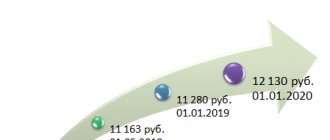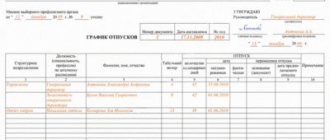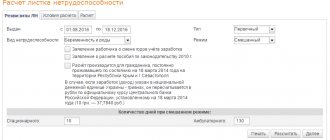Last modified: March 2020
Accidents occur in any company with varying degrees of regularity. Such events occur for various reasons: frivolous neglect of safety measures on the part of the employee, insufficient provision of labor protection measures on the part of the employer, the fault of third parties. As a result, an employee may suffer an injury at work, which can have varying degrees of severity and require companies to carry out a number of mandatory procedures.
How to identify a work-related injury and distinguish it from a domestic injury?
If an employee receives health damage or injury while performing the employer's task, it is identified as a work-related injury. To classify an incident as one that occurred due to the fault of the company, it must meet a number of criteria, which are reflected in the table.
| Person injured | Nature of injury | Consequences of the incident | Time and place of incident |
| Citizens with whom an employment contract has been concluded | Injury or injury caused by third parties | Temporary or permanent disability | During working hours, during a business trip |
| Persons with whom the company has entered into a civil contract, which provides for the payment of insurance premiums for injuries | Consequences of explosions, accidents, electric shocks, fires, destruction of structural elements of buildings and structures | The need to transfer to another job | During breaks for meals and rest |
| Participants of the student agreement, as well as those undergoing practical training | Consequences of force majeure events or emergency circumstances | During the journey to the place of work and back home | |
| When performing actions on behalf of and with the knowledge of the employer |
Although there is no single list of criteria for classifying an injury as a domestic injury, the following circumstances allow it to be classified in this category:
- The damage was caused by taking alcohol, drugs or toxic substances;
- The damage was received as a result of illegal actions of a person classified as criminal offenses.
If any of the criteria given in the table above are not met, then the injury also falls into the domestic category. The final decision on the nature of the injuries received and whether the injury is considered industrial is made by a specially created commission after an investigation.
What should an employer do if an employee is injured?
The list of actions that an employer should take upon discovery of a work-related injury is strictly regulated. In such a situation you should:
- Provide first aid to the injured person, if necessary, call an ambulance or take him to the hospital;
- Ensure that the scene of the incident remains unchanged, or record on a photo or video camera the entire situation at the time of the incident;
- Receive a medical report in form No. 315/у –;
- Notify regulatory authorities and interested services about the incident;
- Conduct an accident investigation.
Each step consists of a set of activities that must be carried out.
How to provide first aid to a victim?
Immediate provision of primary care to an injured person is the direct responsibility of the employer. For this purpose, the organization creates a special post with a medical kit equipped for such cases. Therefore, the employer must:
- Use the primary medical care available to him;
- If you receive a serious injury, call an ambulance or, if the victim can be transported, take him to a medical facility yourself;
- Even if an employee feels fine after primary care, it is necessary to insist on his visit to a medical facility for examination.
The transfer of a transportable victim to the hospital is carried out by the company's vehicle and at its expense.
In the hospital it will be possible to finally ascertain what kind of damage, mild or severe, was received.
Obtaining a medical report on an injury
A conclusion on the nature of the injury received is issued by a health care institution at the request of the employer. There is no official format for such an appeal, so it can be drawn up in any form in the form of a letter from the director of the company to the head of the medical institution. The request is submitted:
- To the institution where the victim was brought immediately at the time of the incident in case he was not admitted to the hospital;
- To the institution where he received inpatient treatment, subject to hospitalization of the victim.
A medical report is issued immediately after receiving an official written request.
Emergency doctors do not have the right to issue a document in form No. 315/u.
What to do with the scene?
As soon as the fact is established that an employee has been injured, the scene of the event must be kept intact. This will help with further investigation into the circumstances of the incident. If it is impossible to maintain the situation, you must:
- Draw a diagram or plan of the scene of the incident;
- Take photographs or video of the entire environment;
- Carry out other available activities, such as writing a text description of the environment.
The materials created in this way will need to be included in the investigation materials.
Which authorities should be notified of an injury and in what order?
The list of government agencies that should be notified in the event of an injury depends on its severity. It is determined by the characteristics given in the medical report.
| Accident category | Institution to be notified | Notice period | Notification Format |
| Receiving an injury of any class recognized as work-related | FSS branch at the place of registration of the company | No later than 24 hours from the moment of the incident | The form was approved by Order of the Federal Social Insurance Fund of the Russian Federation dated August 24, 2000 No. 157 – |
| Injury to a group of employees, serious injury or incident resulting in death |
| No later than 24 hours from the moment of the incident | Form 1 approved by Resolution of the Ministry of Labor of Russia dated October 24, 2002 No. 73 – |
If an employer ignores his obligation to inform the Federal Social Insurance Fund of the Russian Federation, he faces: a fine for an organization - 5,000 to 10,000 rubles, for officials - from 500 to 1,000 rubles.
The notification is transmitted by any available method, taking into account available means of communication, including telephone or fax. Sending a report of an injury must be documented:
- By marking the date and time of departure on the form itself;
- By entering similar data into a special journal.
If the incident is serious or results in death, the employer is obliged to notify the relatives of the victim.
How is the commission for investigation formed?
A commission to investigate an accident is created by the organization and only if the employee performed work under a GPC agreement, will a GIT employee study the circumstances of the incident. If an employee is sent on a business trip or to perform work for another employer, the investigation must be organized by the receiving company.
The commission is appointed by order of the head, which specifies:
- List of commission members;
- The challenges facing it;
- The period of its work;
- Other parameters of the ongoing investigation.
If the facility where the incident occurred is under the jurisdiction of one of the territorial regulatory authorities (for example, Rostechnadzor ), then the composition of the commission must be approved by this institution. The commission must include:
- Occupational safety specialist;
- Employer representatives;
- Representatives of a trade union or workers' association.
There is no unified form for an order to appoint a commission for investigation, and the company can itself develop its form -. As a rule, the head of the company himself is appointed as the chairman of the commission.
What is the time frame for the investigation?
The time frame for taking action in the event of an accident depends on the severity of the incident, as indicated in the medical report. The investigation period may be as follows:
- For minor injuries – 3 days;
- For severe cases – 15 days.
The period begins to run from the date of creation of the order appointing the commission.
In some cases, it is possible to extend the period of investigative measures, but not more than 15 days. Such circumstances include:
- Carrying out additional investigative actions, checking facts;
- Waiting for the final conclusion of doctors;
- The need for additional examinations;
- The need for the participation of inquiry bodies, investigative bodies or the court;
- Remoteness of the incident site from populated areas.
As a rule, an increase in the investigation period is formalized by issuing an additional order.
How is the investigation going?
The investigation procedure includes the following steps:
- Interviewing witnesses and eyewitnesses;
- Thorough study of the scene of the incident;
- Inviting, if necessary, experts to assess the circumstances;
- Collection of documents for analysis: Extracts from logs of initial briefing;
- Description of the workplace;
- Documents on the issuance of protective clothing and protective equipment to the victim;
- Extracts from inspection reports of supervisory authorities.
If necessary, the list of requested information can be expanded. Material and transport support for the commission is provided by the employer at his own expense.
Results of the investigation and their presentation
As a result of all investigative measures, the commission establishes:
- Causes and circumstances of the incident;
- Persons responsible for the incident;
- Whether the injury occurred while performing a work task;
- Determines recommendations to prevent similar incidents in the future;
- Establishes the degree of guilt of the victim;
- Determines whether the injury is work-related.
The results of the investigation are documented in an act in form N-1 for each victim -. The act is drawn up in 2 copies, for the company and the employee; if the injured person is insured by the Social Insurance Fund, then 1 more copy is drawn up for the fund. It is sent to the FSS within 3 days from the end of the investigative measures.
If the injury was received by a group of people or is considered severe, then in addition to it, an accident investigation report is drawn up in Form 4 -.
Also, within 3 days after the end of an accident that resulted in serious injury or death of the victim, the following are sent to the prosecutor’s office:
- Act in form 4;
- Copy of act N-1;
- Copies of documents from the investigation.
Also, in severe cases, copies of these documents are sent to the State Tax Inspectorate and the authorities of the constituent entity of the Russian Federation, the territorial association of trade unions. For them, the deadline for transferring materials is not regulated by law.
How to try to avoid unpleasant consequences
Legal entities cannot be absolutely sure that the herbal obtained is industrial and did not appear out of thin air.
Therefore, employer representatives should prepare in advance for adverse consequences and, if possible, avoid them or at least minimize them:
- First of all, you should familiarize your employees with the safety and labor protection instructions against signature, and be sure to indicate the date of familiarization,
- It is worth conducting briefings periodically and with documentary evidence of their implementation, which is stored in a safe place,
- It is worth remembering that even if the secretary came in high heels and fell down the stairs, then the fault in this case will be the manager’s if he does not prove that she was familiar with the instructions, and the instructions must necessarily specify the comfort of the shoes,
- It is worth developing a certain sequence of your actions in the event of an injury at work. Every employee should be familiar with it, especially department heads. Competent first aid is also an important factor that can save lives and reduce the severity of injuries,
- If you keep the scene of the incident intact, this will facilitate a quick investigation of the incident and identification of those responsible. This will be especially useful if the cause was the actions of the victim himself.
Watch the video. Work injury: workers' rights and employer's responsibilities
https://youtu.be/xHdbbOGyqbI
What can an employer face as a result of an injury?
Based on the results of an investigation into the cause of an employee’s injury, the employer (its officials) may be subject to:
- Disciplinary punishment in the form of a reprimand, reprimand or dismissal;
- Administrative punishment;
- Criminal punishment.
If, as a result of the investigation and possible subsequent inspection of the accident, a violation of labor protection rules is established, he may be subject to penalties under Art. 5.27.1 Code of Administrative Offenses of the Russian Federation. In this case, he faces fines:
- For legal entities from 50,000 to 80,000 rubles;
- For entrepreneurs from 2,000 to 5,000 rubles;
- Officials can pay from 2,000 to 5,000 rubles.
In addition, this article provides for other consequences for the employer for violating the rules of special assessment and allowing an employee to work without instructions.
In case of serious injury to an employee through the fault of the employer, criminal liability measures may be applied (Article 143 of the Criminal Code of the Russian Federation):
- Fine up to 400,000 rubles. or the income of the guilty person for a period of up to 18 months;
- Correctional labor for a period of up to 2 years;
- Imprisonment for up to 1 year.
If the injury results in death, the company official is subject to harsher penalties.
Management's responsibility for concealing the fact of an injury at work
An industrial form of injury that occurs to an employee for various reasons must be recorded and an investigation conducted in accordance with the legislative framework of the state.
If the management of the organization where the emergency occurred refuses to draw up an inspection report and record the fact of an injury at work, then the victim has the right to appeal to local authorities, as well as to the prosecutor’s office and the court.
To confirm the fact of an injury on the production site, the employee provides video footage of the scene of the incident and the injury, as well as photographs and written testimony of witnesses to the injury.
If the fact of a work-related injury is proven in court, then the victim has every right to all payments, and the employer will be held administratively liable, and in complex cases of concealing a death at work, even criminally liable.
https://youtu.be/MLIEGxUoZzA
What payments are due to a victim due to an injury?
If the injury is recognized as work-related, the injured employee is entitled to the following payments:
- Sick leave during treatment;
- One-time and monthly insurance payments;
- Payment of expenses for subsequent rehabilitation.
All of the above amounts are financed by the Social Insurance Fund, with the exception of:
- Sick leave (the first 3 days are paid for by the employer);
- Additional vacation is not a period of sanatorium treatment;
- Travel to the place of sanatorium treatment.
Sick leave due to injury is paid in the amount of 100% of earnings, regardless of the length of insurance coverage. Its maximum cannot be more than four times the social benefit limit (RUB 77,283.86).
The employee may also try to recover moral damages and lost earnings from the employer through the court.








